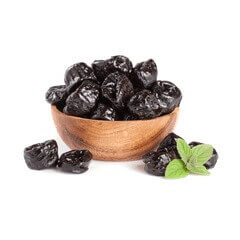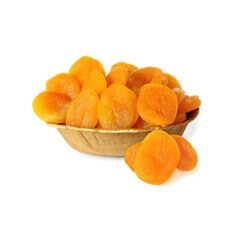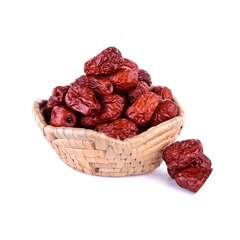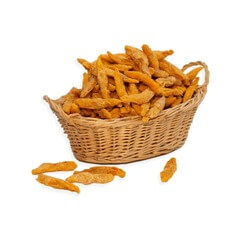Rice Flour: Close-Up on a Gluten-Free Flour
The second most cultivated cereal in the world after wheat, rice has been present in South and East Asia for millennia. It is notably consumed in the form of flour, used to make noodles and rice paper. With the rise of gluten-free diets in Europe, brown, semi-brown, white, or glutinous rice flour is attracting growing interest from consumers to become one of the preferred alternatives to wheat flour.
It must be said that it does not lack assets! In addition to its absence of gluten, it is distinguished by its ease of assimilation by the body, its fine and slightly grainy texture, which makes it an ingredient of choice for pastries, cookies, biscuits, and other shortbreads, and its rather neutral taste which facilitates its use in cooking, alone or combined with other flours. Find everything you need to know about rice flour in the following article!
Rice Flour: History and Production
History and Origin of Rice Flour
Rice cultivation is said to have originated more than 3000 BC in China, where farmers developed sophisticated irrigation techniques that gradually spread throughout much of Asia.
Rice then arrived in Greece around 320 BC, in the wake of the conquests of Alexander the Great. He gradually became known to all the Europeans, who in turn took him to Africa around the 5th century through Portuguese and Dutch navigators, then to America from 1492.
Rice flour is becoming very popular in the world, especially in Europe.

Why Use Rice Flour?
There are many reasons to use rice flour! One of them is its absence of gluten, a viscous substance responsible for inflammatory reactions in the small intestine, allergies, abdominal pain or diarrhea in people with celiac disease or very sensitive to this protein.
In a recipe, rice flour can therefore replace any flour containing gluten (wheat, rye, barley etc.). It also has several advantages over other gluten-free flours thanks to the following:
- It has a very neutral taste, which makes it easy to incorporate into a wide variety of recipes (cakes, pancakes, biscuits, etc.)
- It is more digestible character than other flours, such as corn
- Its nutritional qualities, especially when it comes to wholemeal or semi-wholemeal flour
What Are The Nutritional Qualities Of Rice Flour?
If rice flour is as caloric as wheat flour (366 Kcal of calories / 100 g), it is distinguished by its nutritional richness.
100 g of white rice flour thus contains:
- 5.95g protein
- 1.42g fat
- 80.13g carbohydrates
- 2.4g fibre
- 98 mg of phosphorus
- 76mg potassium
- 2.6 mg vitamin B3 or niacin
- Four µg of vitamin B9 or folate
Rice flour is an excellent energy source thanks to its high content of carbohydrates, B vitamins and essential minerals such as potassium and phosphorus. It also contains starch, known for its health benefits for hair and skin.
This nutritional composition varies, however, depending on the type of rice used, with brown or semi-brown rice flour being even richer in minerals and vitamins.
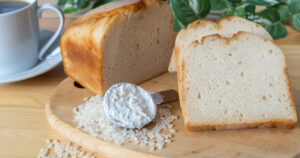
Does Rice Flour Constipate?
It all depends on the type of rice flour you consume! White rice contains less fibre and leaves little residue in the intestine, which limits the stimulation of the colon. It can therefore have a small constipating effect, which is why its consumption is often recommended in case of diarrhea!
Conversely, brown rice flour, and to a lesser extent semi-brown rice flour, is much higher in fibre. It, therefore, retains more water and facilitates transit.
Whole, Semi-Whole or White Rice Flour
As we have seen, there are several types of rice flour:
- white rice flour, the finest and lightest
- semi-complete rice flour
- brown rice flour, also called brown rice or brown rice, is the most nutritionally rich but also the tastiest
White rice and, to a lesser extent, semi-brown rice result from a more or less advanced refining process intended to rid the grains of their outer envelope, germ and bran. This step changes the taste and nutritional qualities, which is why brown rice is richer in nutrients.
There is even a fourth category: glutinous rice flour, which, as the name suggests, is made from glutinous rice. It is notably used in baking to make Japanese mochis as well as Korean Tteoks and gives them their more elastic texture.
Taste and Nutritional Differences between Different Types of Rice Flour
The rice refining process removes a series of nutrients, including some of the vitamins B3, B1 and B6, as well as a significant amount of manganese, iron and essential fatty acids.
Brown rice flour, for example, contains 80% more fibre than white rice flour, which lengthens the feeling of satiety it provides and facilitates digestion.
Semi-complete rice flour, and especially brown rice flour, also have more interesting taste properties, with their slightly sweet nutty flavour, and give a slightly less crumbly texture to your preparations.
Using one or the other of these three flours will depend, above all, on your preferences!

How to Use Rice Flour?
Rice Flour: Use and Dosage
Rice flour has a consistency quite similar to that of wheat and a fairly neutral taste. It can, for example, be used:
- to prepare light pastries and cakes and offers a slightly sandy texture, ideal for cookies, crumbles, pastry and biscuits
- to thicken sauces, creams or soups
- To bread food and give it a crispy effect
Used alone, it can, however, give a slightly crumbly texture to your preparations. This is why combining it with other flours is advisable, and we will return to this. Also, the lack of gluten makes it unsuitable for bread, so you’ll need to add yeast if you want to make bread from rice flour.
How to Replace Wheat Flour with Rice Flour?
Thanks to its fairly neutral taste, it is easy to replace wheat flour with rice flour in a cake recipe! For more flavours, you can even combine it with other more distinctive flours (chestnut, buckwheat, chickpea flour, etc.).
To replace 100g of wheat flour, mix 50g of rice flour with 30g of potato starch and 20g of cornstarch. The result will be quite similar in taste and texture.
Mix it with starch or almond powder to reduce its crumbly side and make your preparations softer. A useful little trick when preparing muffins or blinis!
Finally, what flour can replace rice flour? Any flour with or without gluten, from corn flour to quinoa flour, to millet flour.
Where Can I Find Rice Flour?
Still uncommon fifteen years ago, rice flour is experiencing a growing craze. You can now find it in most supermarkets and all stores.
Visit the ADNOOR website to get the best Long-Grain Basmati Rice, Premium Long Grain Sella Rice, white rice, Brown Super Kernel Basmati Rice, nuts, seeds, and dried fruits. We take pride in saying that we are the Best Basmati rice brand in Canada and have been the importers, exporters, wholesalers, distributors, and co-packers of various nuts and grains in Canada for the last 25 years. So, without wasting time, visit our website and order what you need.




